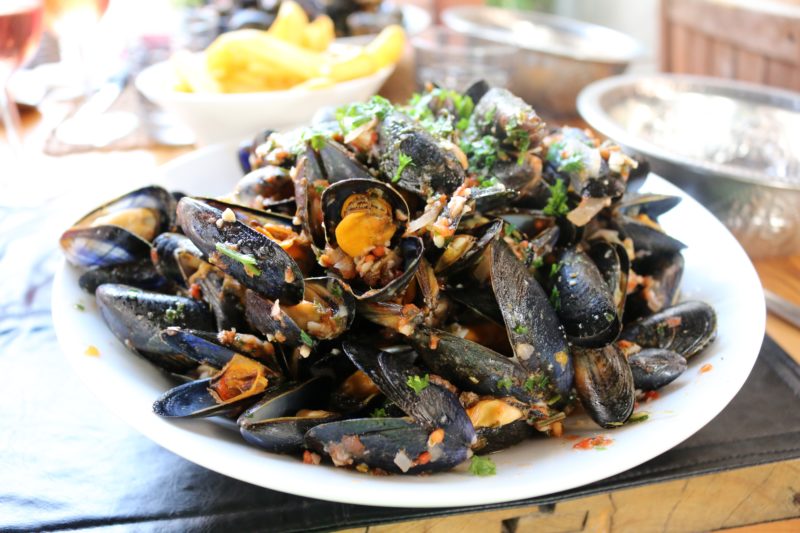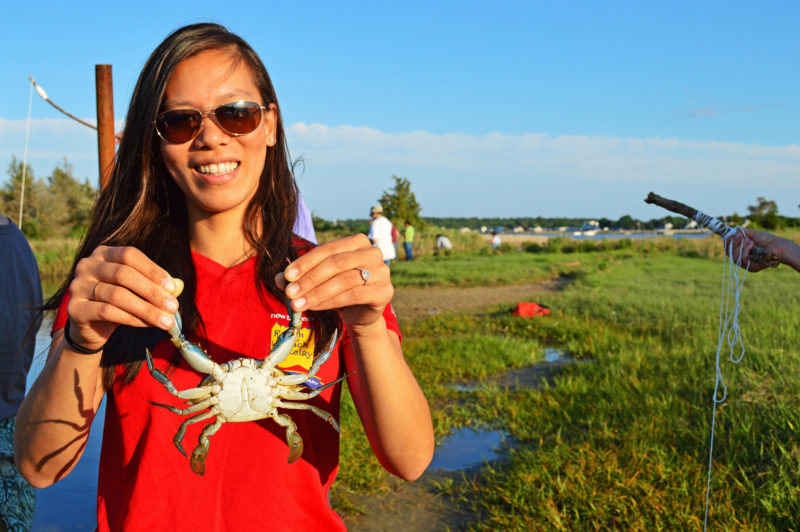Delicious coastal recipes to try using 12 ingredients you can harvest from Buzzards Bay
Clean water in Buzzards Bay gives us beautiful places to explore and healthy places for fish, clams, scallops, and other underwater species to live. It also has another, delicious upside — fantastic seafood for your dinner table! Eating locally is an incredible way to connect with the environment that surrounds you. With every bite, you can appreciate our local fish and shellfish species and the clean water that sustains them.
For some inspiration, we’ve gathered some classic and creative ways to prepare Buzzards Bay’s coastal favorites – from the tried and true to new ingredients that you may not have ever considered putting on your plate. Although many of the species listed below are available at your local fish market, we recommend getting outside and catching your own!

Whether you plan to fish from the shore or hop on a boat, you’ll need a state recreational saltwater fishing permit if you’re 16 years old or over.
Fish
Whether you plan to fish from the shore or hop on a boat, you’ll need a state recreational saltwater fishing permit if you’re 16 years old or over. Permits are just $10 for anglers between the ages of 16-59 and free for anglers 60 and older. Also, make sure to follow all recreational finfish regulations for season, size, and possession limits.
Striped Bass
It’s no surprise striped bass are one of Buzzards Bay’s most popular recreational species. These big, powerful fish are challenging to lure in and put up a good fight when hooked. They’re also as delicious as they are fun to catch. Striped bass meat has a texture that’s flaky but firm, with a rich, mineral flavor. It takes well to an array of cooking methods, from frying to smoking to grilling.
Striped bass recipes to try: Whole striped bass with lemon and mint (Bon Appetit), Striped bass with clams, black olives, and chorizo (New England Today), Striped bass poached in spicy soy sauce (New York Times)

Black sea bass are beautiful fish that hold up well to grilling and baking. (Image: Tom Schlichter, OutdoorTom.com)
Black Sea Bass
Strikingly beautiful black sea bass migrate into Buzzards Bay and Vineyard Sound from May through June to spawn. During the spring spawning season, these bottom-dwellers become particularly aggressive and fun to catch. Black sea bass has a delicate flavor and a firmer, less oily texture than their striped cousins – meaning they hold up particularly well to grilling or baking whole.
Black sea bass recipes to try: Lime and cilantro stuffed black sea bass (Bon Appetit), Braised black sea bass (Fine Cooking), Crispy-skin black sea bass with avocado, tomatillo, and fennel relish (Food Network)
Bluefish
Anglers have a healthy measure of respect for bluefish, which form exciting feeding frenzies near the water’s surface in late summer and put up quite a fight when hooked. But when it comes to eating, bluefish’s strong marine flavor is polarizing. When cleaned and stored properly and eaten very fresh, bluefish can be delicious. Its flavor lends itself particularly well to the smokiness of grilling and smoking.
Bluefish recipes to try: Grilled bluefish with summer green goddess dressing (New England Today), Smoked bluefish pâté (Food and Wine), Bacon-wrapped baked bluefish (Saveur)
Tautog

Look for tautog hiding near rocks, reefs, piers, and ledges. (Image: Tom Richardson/New England Boating)
Salt Water Sportsman calls the tautog “one of the most cerebral fish in the ocean.” Also known as blackfish, these wreck-dwelling wrasses are so tricky to catch that skilled tautog fishermen keep their technique a guarded secret. If you do manage to land one of these fascinating fish during their fall runs through Buzzards Bay, you’re in for a culinary treat: tautog’s off-white flesh is firm and creamy, with a distinctive earthy flavor.
Tautog recipes to try: Grilled whole tautog (On the Water), Parmesan-crusted tautog with herb-lemon sauce (My Fishing Cape Cod), Roasted blackfish with olives and sage (Serious Eats)
White Fish (Scup, Fluke, Flounder)
“White fish” is a term that you may often come across in seafood recipes. While each of these fish is wildly different in the eyes of anglers and scientists, they’re much the same to a chef: all are tender, delicate, and flaky, with a mild and buttery flavor. These “white fish” are largely interchangeable for the recipes below, though we encourage you to test your palate and give them all a try!
White fish recipes to try: Roasted scup with briny herb sauce (Edible Boston), Crispy summer flounder with scallion-corn ragout (New England Today), Flounder with lemon butter sauce (Leite’s Culinaria), Baked flounder with parmesan crumbs (Food & Wine)
 Shellfish
Shellfish
Like fishing, recreational shellfishing requires a permit – but shellfishing licenses come from your local town rather than the state. Every town has different license fees, regulations, and open shellfishing areas and seasons, so check with your town’s shellfish warden or town clerk for more information. (Here’s a handy list of links to shellfishing information in every Buzzards Bay town, and this map shows the waterways where you might find different species.) There are also state-wide recreational shellfish regulations for clams, bay scallops, oysters, and other popular species.
Quahogs
Abundant, delicious, and easy to harvest, quahogs are by far the most popular shellfish species on Buzzards Bay. Whether you’re digging your own or buying from a local supplier, you’ll need to pick the size of clam you bring home based on what you’re going to cook: smaller littlenecks, cherrystones, and steamers are good to eat whole, while large, robust “chowder clams” are great for – you guessed it – chowder, as well as stuffies.
Quahog recipes to try: New England clam chowder (A Family Feast), New England stuffies (Azorean Green Bean), Chile-lime clams with tomatoes and grilled bread (Bon Appetit)
Oysters

Oysters are popularly eaten raw and “on the half shell.”
Purists will say that the only way to eat an oyster is raw, or “on the half shell,” swimming in the salty liquid that these bivalves retain after harvesting. If you’re new to the idea of slurping oysters raw, try them first with a dash of lemon juice, cocktail sauce, horseradish, or a classic mignonette, a flavorful sauce that compliments oysters’ sweet, mineral flavor. But if you can’t quite stomach these shellfish raw, don’t fret: there are many delicious ways to enjoy oysters cooked instead!
Oyster recipes to try: Raw oysters with blueberry mignonette & mint (The Coastal Table), Oysters Rockefeller (Taste of Home), Oyster dip with bacon (The Coastal Table), Oyster stew (Yankee Magazine)
Bay Scallops
Bay scallops are one of Buzzards Bay’s signature species. Although cloudy, nitrogen-polluted waters have caused bay scallops to suffer a stunning collapse over the last 40 years, you can still harvest them recreationally from the Bay during their fall/winter season. If these delicious shellfish end up in your kitchen, you’re in luck: bay scallops are so sweet and delicate that you could easily sear them unseasoned in a frying pan and call it dinner. Just be sure not to overcook them, as they have a very tender texture and only need a few minutes before they’re done.
Bay scallop recipes to try: New England scallop chowder (Emeril Lagasse), Bay scallops sautéed with almonds and orange (Yankee Magazine), Buttery bay scallop casserole (Coastal Inspired Cuisine)

Mussels have a rich, savory flavor and cook up in just a few minutes.
Mussels
Blue mussels are among the easiest shellfish to harvest yourself. Since they grow directly on hard surfaces along the shoreline, gathering mussels is as simple as measuring their size and plucking them off a rock. Once you’ve cleaned their shells and removed their “beards” (the thread that attaches mussels to rocks), you can cook them up in just minutes. Mussels have a rich, savory flavor that pairs particularly well with garlic.
Mussel recipes to try: Portuguese-style mussels in garlic cream sauce (A Family Feast), Strawberry tomato rosé mussels (The Coastal Table), Mussels with Thai red curry broth and rice noodles (Serious Eats)
Periwinkles
You’ve certainly seen these abundant snails latched to rocks around the Bay’s shores, but did you know that you can eat them? Periwinkles are a popular food in Portugal, Spain, and the UK (where gathering them is called “winkling”). Use a pin or toothpick to pull them from their shell, and you’ll see the periwinkles have a surprisingly long (and curly!) body, with a soft texture and a flavor similar to a quahog.
Periwinkle recipes to try: “Shoreline stew”: Portuguese-style pork and clams with periwinkles (Three Tastes), Scituate periwinkles with hard cider and seaweed (Eat the Invaders), Cantonese-style periwinkles in black bean sauce (The Woks of Life)
Blue Crabs

Blue crabs are both delicious and fun to catch yourself!
Although blue crabs might be known as the signature shellfish of mid-Atlantic states, they can also be found around Buzzards Bay’s shallow, marshy areas, like rivers, estuaries, and tidal creeks. These feisty crabs are fun to catch with kids, and you don’t need a permit in Massachusetts if you’re catching them by hand. You can take home as many as 25 five-inch-wide crabs per day, and from there start experimenting with the many ways to cook and eat these “beautiful swimmers.”
Blue crab recipes to try: Steamed blue crabs (New York Times), Mac’s crab dip (Cape Cod Life), Crab and Irish whiskey bisque (Saveur)
Seaweed
Yes…seaweed! Hailed as the “next kale,” this superfood goes beyond sushi wrappers. Try seaweed raw in a salad, dried and sprinkled on popcorn, layered in a sandwich, wrapped around fish on the grill, or to add thickness and flavor to soups. Down East Magazine has a good guide to edible seaweeds, many of which can be found in Buzzards Bay. Use scissors to snip off the top parts of healthy plants still growing on rocks. (Don’t pick seaweed up off the beach, where it’s already begun to decompose.)
Seaweed recipes to try: Foraged seaweed salad (Honest Food), Seaweed risotto (101 Cookbooks), Sweet sugar kelp crisps (Fish on Friday), Chocolate seaweed ice cream (University of New Hampshire)